Romanticism in Art: Comparing Neoclassicism and Romanticism
Unlock all answers in this set
Unlock answersquestion
Goals

answer
* Discuss Romanticism as an artistic style. Name some of its frequently occurring subject matter as well as its stylistic qualities. * Compare and contrast Neoclassicism and Romanticism. * Examine reasons for the broad range of subject matter, from portraits and landscape to mythology and history. * Discuss initial reaction by artists and the public to the new art medium known as photography
question
27.1 From Neoclassicism to Romanticism
answer
* Understand the philosophical and stylistic differences between Neoclassicism and Romanticism. * Examine the growing interest in the exotic, the erotic, the landscape, and fictional narrative as subject matter. * Understand the mixture of classical form and Romantic themes, and the debates about the nature of art in the 19th century. * Identify artists and architects of the period and their works.
question
Neoclassicism in Napoleonic France
answer
*Understand reasons why Neoclassicism remained the preferred style during the Napoleonic period * Recall Neoclassical artists of the Napoleonic period and how they served the Empire
question
Figure 27-2 JACQUES-LOUIS DAVID, Coronation of Napoleon, 1805-1808. Oil on canvas, 20' 4 1/2" x 32' 1 3/4". Louvre, Paris.

answer
As First Painter of the Empire, David recorded Napoleon at his December 1804 coronation crowning his wife (Josephine) with the pope as witness, thus underscoring the authority of the state over the church. Although this painting appears at first to be a detailed, objective record of an historical event, it is, in fact, a carefullly crafted tableau designed to present Napoleon in the way he wished to be seen. For instance, this picture clearly shows his mother but in fact, she refused to attend.
question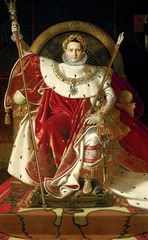
27-2A JEAN-AUGUSTE-DOMINIQUE INGRES, Napoleon on His Imperial Throne, 1806. Oil on canvas, 8' 8 5/8" X 5' 3". Musée de l'Armée, Palais des Invalides, Paris.

answer
Napoleon expressing his imperial authority.
question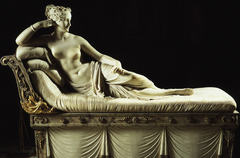
Figure 27-4 ANTONIO CANOVA, Pauline Borghese as Venus, 1808. Marble, 6' 7" long. Galleria Borghese, Rome.

answer
This is the sister of Napoleon who insisted as being depicted as Venus, the goddess of love. Canova wanted to depict her as Diana, goddess of the hunt.
question
27-4A ANTONIO CANOVA, Cupid and Psyche, 1787-1793. Marble, 5' 1" high. Louvre, Paris.

answer
Canova gained renown for his sculptures of classical gods and heroes such as this.
question
Foreshadowing Romanticism
answer
* Notice how David's students retained Neoclassical features in their paintings * Realize that some of David's students began to include subject matter and stylistic features that foreshadowed Romanticism
question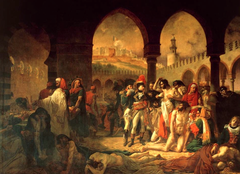
Figure 27-1 ANTOINE-JEAN GROS, Napoleon at the Pesthouse at Jaffa, 1804. Oil on canvas, 17' 5" x 23' 7". Louvre, Paris.

answer
Napoleon, fearless ampong the plague-stricken, reaches out to touch one man's sores with bare hands. Gros portrayed the French general as Christlike, implying he possessed miraculous powers to heal the sick.
question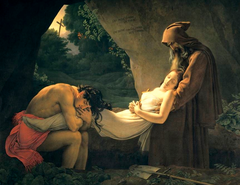
Figure 27-5 ANNE-LOUIS GIRODET-TRIOSON, The Burial of Atala, 1808. Oil on canvas,. 6' 11" x 8' 9". Louvre, Paris.

answer
Girodet's depiction of Native American lovers in the Louisiana wilderness appealed to the French public's fascination with what is perceived as the passion and primitivism the New World.
question
27-5A ANNE-LOUIS GIRODET-TRIOSON, Jean-Baptiste Belley, 1797. Oil on canvas, 5' 2 1/2" X 3' 8 1/2". Musée Nationale du Château de Versailles, Versailles.

answer
Evidence of Girodet addressing contemporary themes in his painting, as he did here in this portrait of Jean-Baptiste Belley, a French legislator and former slave.
question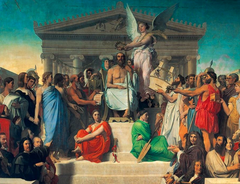
Figure 27-6 JEAN-AUGUSTE-DOMINIQUE INGRES, Apotheosis of Homer, 1827. Oil on canvas, 12' 8" x 16' 10 3/4". Louvre, Paris.

answer
Inspired by the school of Athens, by Raphael, Ingres's favorite painter, this monumental canvas is a Neoclassical celebration of Homer and other ancient worthies, Dante, and select French authors.
question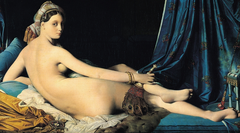
Figure 27-7 JEAN-AUGUSTE-DOMINIQUE INGRES, Grande Odalisque, 1814. Oil on canvas, approx. 2' 11 7/8" x 5' 4". Louvre, Paris.

answer
This again shows Ingres's admiration of Raphael in his borrowing of that master's type of female head. The figure's languid pose, small head and elongated limbs, and the generally cool color scheme reveal the painters debt to Parmigianino and the Italian Mannerists. He painted the woman in a Turkish harem, which made strong concessions to the burgeoning Romantic taste for the exotic.
question
27.2 The Rise of Romanticism
answer
Whereas Neoclassicism's rationality reinforced Enlightenment thought, particularly Voltaire's views, Rousseau's ideas contributed to the rise of Romanticism. Rousseau's exclaimation," Man is born free, but is everwhere in chains!" - the opening line of his Social Contract, summarizes a fundamental Romantic premise. Romanticism emerged from a desire for freedom - not only political freedom, but also freedom of thought, of feeling, of action, of workship, of speech, and of taste. Romantics asserted freedom was the right and property of all. They believed the path to freedom was through imagination rather than reason and functioned through feeling rather than through thinking.
question
Features of Romanticism : P. I. N. E.
answer
P. I. N. E. - Past - longing for the medieval past, pre-industrial Europe (Gothic architecture will be revived) - Irrational/ Inner mind / Insanity - Romantic artists depict the human psyche and topics that transcend the use of reason. One Romantic artist, Gericault chose to do portraits of people in an insane asylum. - Nature - longing for the purity of nature, which defies human rationality - Emotion/ Exotic - Romantics favored emotion and passion over reason. Exotic themes and locales were also popular because they did not adhere to European emphasis on rationality.
question
Figure 27-8 HENRY FUSELI, The Nightmare, 1781. Oil on canvas, 3' 4 3/4" x 4' 1 1/2". The Detroit Institute of the Arts (Founders Society Purchase with funds from Mr. and Mrs. Bert L. Smokler and Mr. and Mrs. Lawrence A. Fleishman).
answer
The transition from Ceoclassicism to Romantisicm marked a shift in emphasis from reason to feeling. Fuseli was among the first painters to depict the dark terrain of the human subconscious. Fuseli specialized in night moods of horror and in dark fantasies - in the demonic, in the macabre, and often in the sadistic.
question
For people living in the 18th Century, the Middle Ages were the
answer
"dark ages", a time of barbarism, superstition, dark mystery, and miracle. The Romantic imagination stretched its perception in the Middle Ages into all the worlds of fantasy open to it, including the ghoulish, the infernal, the terrible, the nightmarish, the groutesque, the sadistic, and all the imagery that comes from the chamber of horrors when reason sleeps.
question
Related to the imaginative sensibility was the period's notion of the
answer
sublime. Among the individuals most involved in studying the sublime was the British politican and philosopher Edmund Burke. Burke articulated his definition of the sublime - feelings of awe mixed with terror. Burke observed that pain or fear evoked the most intense human emotions and that these emotions could also be thrilling. Thus, raging rivers and great storms at sea could be sublime to their viewers. Accompanying this taste for the sublime was the taste for the fantastic, the occult, and the macabre - for the adventures of the soul voyaging into the dangerous reaches of the imagination.
question
Figure 27-9 WILLIAM BLAKE, Ancient of Days, frontispiece of Europe: A Prophecy, 1794. Metal relief etching, hand colored, 9 1/2" x 6 3/4". The Whitworth Art Gallery, Pierpont Morgan Library, New York.
answer
Although historians classify Blake as a Romantic artist, he incorporates classical references in his works. Here, ideal classical anatomy merges with the inner dark dreams of Romanticism. Blake greatly admired the ancient Greek art because it exemplified for him the mathematical and thus eternal, and his work often incorporated classical references.
question
Drama, Action, and Color in Spanish Romanticism
answer
Examine the issues of drama, action, and color in the art of Francisco Goya.
question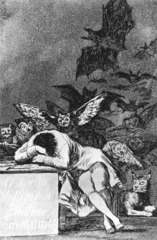
Figure 27-10 FRANCISCO GOYA, The Sleep of Reason Produces Monsters, from Los Caprichos, ca. 1798. Etching and aquatint, 8 1/2" x 5 7/8". Metropolitan Museum of Art, New York (gift of M. Knoedler & Co., 1918).

answer
Romantic artists, including Francisco Goya in Spain and Theodore Gericault and Eugene Delacroix in France, reveled in exploring the exotic, erotic, and fantastic. In this print, Goya depicted himself alseep while threatening creatures converge on him, revealing his commitment to the Romantic spirit - the unleashing of imagination, emotions, and nightmares.
question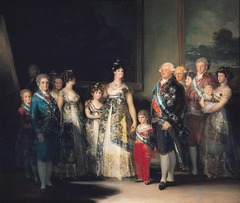
Figure 27-10A FRANCISCO GOYA, The Family of Charles IV, 1800. Oil on canvas, approx. 9' 2" x 11'. Museo del Prado, Madrid.

answer
In 1786 Goya became the official artist in the court of Charles IV and produced portraits of the family. It has been suggested that this portrait is a political statement regarding the inept ability of the king and the unscrupulous stupidity of the queen. Has Goya caught those character traits forever? The positioning of the family members allows the viewer to create a personal dialog with the various characters. But there is an ambiguity in the portrait, some of the family members do establish eye contact with the viewer while others are simply starring off into space or as one female member turning her head to the back of the interior space the family occupies.
question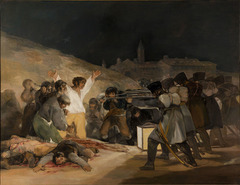
Figure 27-11 FRANCISCO GOYA, Third of May, 1808, 1814. Oil on canvas, 8' 9" x 13' 4". Museo del Prado, Madrid.

answer
Goya encouraged empathy for the massacred Spanish peasants by portraying horrified expressions on their faces, endowing them with a humanity lacking in the French firing squad.
question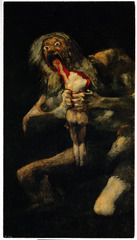
Figure 27-12 FRANCISCO GOYA, Saturn Devouring One of His Children, 1819-1823. Detached fresco mounted on canvas, 4' 9 1/8" x 2' 8 5/8". Museo del Prado, Madrid.

answer
Over time, Goya became increasingly disillusioned and pessimistic, and his declining health further contributed to this state of mind. PG. 764 This disturbing fresco in Goya's farmhouse uses a mythological tale to express the artists despair over the passage of time. Saturn's Greek name Kronos is similar to the Greek word for "time." Despite the simplicity of the image, it conveys a wildness, boldness, and brutality that evokes an elemental response from all viewers.
question
The French Debate: Color vs. Line
answer
* Understand the French debate over theories related to color (expression) vs. line (drawing or form) as appropriate to artistic expression. * Realize that this debate has roots in the paintings and ideas of Nicolas Poussin, considered to have set the canon for French academic paintings, and the works of Peter Paul Rubens, most famous for his rich and sensuous colors. * Differentiate between Poussinistes and Rubenistes.
question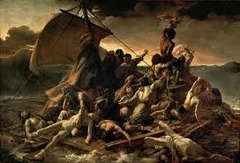
Figure 27-13 THÉODORE GÉRICAULT, Raft of the Medusa, 1818-1819. Oil on canvas, 16' 1" x 23' 6". Louvre, Paris

answer
In this gigantic history painting, Gericault rejected Neoclassical compositional principles and, in the Romantic spirit, presented a jumble of writhing bodies in every attitude of suffering, despair, and death. The subject of Raft of the Medusa is the 1816 shipwreck off the African coast of the French frigate Medusa, which ran aground on a reef due to the incompetence of the captain, a political appointee. In an attempt to survive, 150 passengers built a makeshift raft from pieces of the disintegrating ship. The raft drifted for 12 days, and the number still alive dwindled to 15. Finally, a ship spotted the raft and rescued the emaciated survivors. This horrendous event was political dynamite once it became public knowledge. This is also the artist's commentary on the practice of slavery. Gericault was a member of an abolitionist group that sought ways to end the slave trade in the colonies, the cause promoted in the French legislature by Jean-Baptiste Belley.
question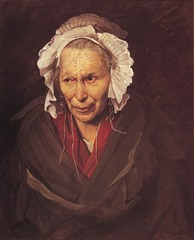
Figure 27-14 THÉODORE GÉRICAULT, Insane Woman 1822-1823. Oil on canvas, 2' 4" x 1' 9". Musée des Beaux-Arts, Lyons.

answer
The insane and the influence of aberrant states of mind on the appearance of the human face fascinated Gericault and other Romantic artists, who rebelled against Enlightenment rationality.
question
Figure 27-15 EUGÈNE DELACROIX, Death of Sardanapalus, 1827. Oil on canvas, 12' 1 1/2" x 16' 2 7/8". Louvre, Paris.

answer
The Death of Sardanapalus is perhaps the grandest Romantic pictorial drama ever painted. Inspired by the 1821 poem by Lor Byron, the painting does not illustrate the text faithfully. The king has just received news of his armies' defeat and the enemies' entry into his city. The setting Delacroix painted is much more tempestous and crowded than Bryon described, and orgiastic destruction has replaced the sacrificial suicide of the poem. See page 766
question
In music,
answer
Franz Schubert, Franz Liszt, Frederic Chopin and Johannes Brahns emphasized the melodic or lyrical. For these composers, music had the power to express the unspeakable and to communicate the subltest and most powerful human emotions.
question
In literature,
answer
Romantic poets such as John Keats, William Wadsworth, and Samuel Taylor Coleridge published volumes of poetry manifesting the Romantic interest in lyrical drama. Ozymandias, by Percy Bysshe Shelley, transported readers to faraway, exotic locales. Byron's poems conjures images of eroticism and fury unleashed - images Eugene Delacroix made concrete inhis painting Death of Sardanapalus. One of the best examples of the Romantic spirit is the engrossing novel FRANKENSTEIN, written in 1818 by Shelley's wife , Mary Wollstonecraft Shelley. Frankenstein served as a cautionary tale of the havoc that could result from unrestrained scientific experimentation and from the arrogance of scientists.
question
Figure 27-16 EUGÈNE DELACROIX, Liberty Leading the People, 1830. Oil on canvas, 8' 6" x 10' 8". Louvre, Paris.

answer
PG. 768
question
What was the argument between the Poussinistes and the Rubenistes at the end of the 17th century and the beginning of the 18th century?
answer
The Poussinistes were conservative defenders of academism who insisted that drawing was superior to color, whereas the Rubenistes proclaimed the importance of color over line (line quality being more intellectual and thus more restrictive than color).
question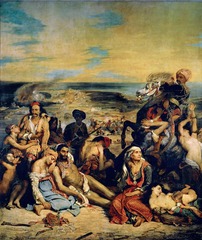
27-15A EUGÈNE DELACROIX, Scenes from the Massacre at Chios, 1822-1824. Oil on canvas, 13' 10" X 11' 7". Louvre, Paris.

answer
Pg 767
question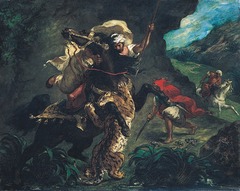
Figure 27-17 EUGÈNE DELACROIX, Tiger Hunt, 1854. Oil on canvas, 2' 5" x 3'. Musée d'Orsay, Paris.

answer
Delacroix's 1832 trip to Morocco inspired Tiger Hunt and had a lasting impact on his art. His paintings of men battling ferocious beasts are consistent with the Romantic interest in exotic places. 769
question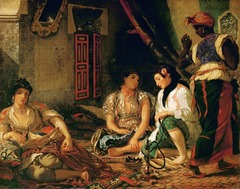
27-17A EUGÈNE DELACROIX, Women of Algiers in Their Apartment, 1834. Oil on canvas, 5' 10 7/8" X 7' 6 1/8". Louvre, Paris.

answer
768
question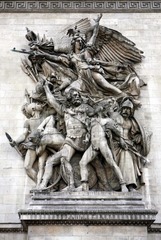
Figure 27-18 FRANÇOIS RUDE, Departure of the Volunteers of 1792 (La Marseillaise), Arc de Triomphe, Paris, France, 1833-1836. Limestone, 41' 8" high.

answer
This relief work decorates on of the arches on the Arc de Triomphe in Paris. This French landmark was an 1806 Napoleonic commission designed by Jean Francios Therese Chalgrin on the model of the triumphal arches of ancient Rome. This historical-allegorical sculpture features the Roman war goddess Bellona, but the violent motion, jagged contours, and densely packed masses typify Romantic painting compositions. 770
question
Landscape painting
answer
came into its own in the 19th century as a fully independent and respected genre. Increasing tourism which came courtesy of improved and expanded railway systems both in Europe and America, contributed to the popularity of landscape painting. The notion of the picturesque became particularly resonant in the Romantic era. Already in the 18th century, artists had regarded the pleasurable, aesthetic mood that natural landscape inspired as making the landscape itself "picturesque"- that is, worthy of being painted.
question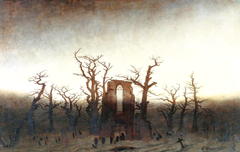
Figure 27-19 CASPAR DAVID FRIEDRICH, Abbey in the Oak Forest, 1810. Oil on canvas, 3' 7 1/2" X 5' 7 1/4". Nationalgalerie, Staatliche Museen zu Berlin, Berlin.

answer
Among the first northern European artists to depict the Romantic transcendental landscape was Caspar David Friedrich. His work balances inner and outer experiences. "The artist," he wrote, "should not only paint what he sees before him, but also what he sees within him. If he does not seel anything within him, he should give up painting what he sees before him."
question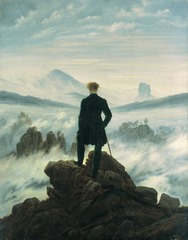
27-20 CASPAR DAVID FRIEDRICH, Wanderer above a Sea of Mist, 1817-1818. Oil on canvas, 3' 1 3/4" X 2' 5 3/8". Hamburger Kunsthalle, Hamburg.

answer
This painting of a solitary man on a rocky promontory gazing at a vast panorama of clouds, mountains, and thick mist perfectly expresses the Romantic notion of the sublime in nature.
question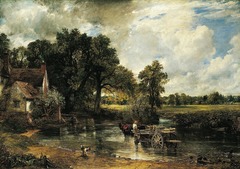
Figure 27-21 JOHN CONSTABLE, The Haywain, 1821. Oil on canvas, 4' 3" x 6' 2". National Gallery, London

answer
The Haywain is a nostalgic view of the disappearing English countryside during the Industrial Revolution. Constable had a special gift for capturing the texture that climate and weather give to a landscape. Constable studies it as a meteorologist, which he was by avocation. His special gift was for capturing the texture that climate and weather, which delicately veil what is seen, give to landscape. Constable's use of tiny dabs of local color, stippled with white, created a sparkling shimmer of light and hue across the canvas surface - the vibration itself suggestive of movement and process. Quoted as saying "Painting is but another world for feeling."
question
Romantic Landscape Painting
answer
* Understand the romantic interest in the landscape as an independent and respected genre in Germany, England, and the United States.
question
Figure 27-22 JOSEPH MALLORD WILLIAM TURNER, The Slave Ship (Slavers Throwing Overboard the Dead and Dying, Typhoon Coming On), 1840. Oil on canvas, 2' 11 11/16" x 4' 5/16". Museum of Fine Arts, Boston (Henry Lillie Pierce Fund).
answer
The essence of Turner's innovative style is the emotive power of color. He released color from any defining outlines to express both the forces of nature and the painter's emotional response to them. This is an incident that happened in 1783. The incident involved the captain of a slave ship who, on realizing his insurance company would reimburse him only for slaves lost at sea but not for those who died in route, ordered the sick and dyinjg slaves thrown overboard. The key ingredient of Turner's highly personal style is the emotive power of pure color.
question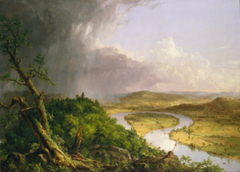
Figure 27-23 THOMAS COLE, The Oxbow (View from Mount Holyoke, Northampton, Massachusetts, after a Thunderstorm), 1836. Oil on canvas, 4' 3 1/2" x 6' 4". Metropolitan Museum of Art, New York (gift of Mrs. Russell Sage, 1908).

answer
An American painter of English birth, Thomas Cole, was often referred to as the leader of the Hudson River School. In America, landscape painting was the specialty of the artist of the Hudson River School. Another issue that surfaced in regards to the Hudson River School painters was the frequent moral question of America's direction as a civilzation. Cole divided his canvas into dark wilderness on the left and sunlit civilization on the right. The minuscule painter at the bottom center seems to be asking for advice about America's future course.
question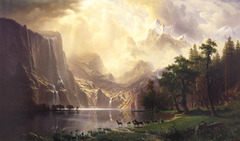
Figure 27-24 ALBERT BIERSTADT, Among the Sierra Nevada Mountains, California, 1868. Oil on canvas, 6' x 10'. National Museum of American Art, Smithsonian Institution, Washington, D.C.

answer
Bierstadt's paintings reinforced the idea of Manifest Destiny. 774 This popular 19th century doctrine held that westward expansion across the continent was the logical destiny of the United States. Painting of the scenic splendor of the West helped to mute the growing concerns over the realities of conquest, the displacement of Native Americans, and the exploitation of the environment. It should come as no surprise that among those most eager to purchase Bierstadt's work were mail-service magnates and railroad builders - entrepreneurs and financiers involved in westward expansion.
question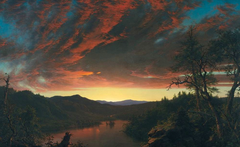
Figure 27-25 FREDERIC EDWIN CHURCH, Twilight In the Wilderness, 1860s. Oil on canvas, 3' 4" x 5' 4". Cleveland Museum of Art, Cleveland (Mr. and Mrs. William H. Marlatt Fund, 1965.233).

answer
Church's paintings eloquently express the Romantic notion of the sublime. Painting during the Civil War, this wilderness landscape presents and idealistic view of America free of conflict. 775
question
27.3 Modernism and Realism
answer
* Examine the meanings of "Modernism" and "Realism" and the rejection of Renaissance illusionistic space. * Understand the changes in Realist art in form, style, and content. * Examine the use of art - especially photography and printmaking -- to provide social commentary.
question
The Art of Realism
answer
* Understand Realist art in its forms, styles, and content. * Examine the social commentary, shocking subject matter, formal elements, and public reaction to Realism.
question
Realism
answer
Advances in industrial technology during the 19th century reinforced Enlightenment faith in the connection between science and progress. Both intellectuals and the general public increasingly embraced empiricism and positivism. To empiricists, the basis of knowledge is observation and direct experience. Positivists ascribed to the philosophical model developed by Auguste Comte, who believed scientific laws governed the environment and human activity and could be revealed through careful recording and analysis of observable data. Comet's followers promote science as the mind's highest achievement and advocated a purely empirical approach to nature and society.
question
Realism was a movement that developed in
answer
France around mid century against this backdrop of an increasing emphasis on science. Realists artists argued that only the contemporary world - what people can see- was "real". Accordingly, Realists focused their attention on the people and events of their own time and disapproved of historical and fictional subjects on the grounds they were neither visible nor present and therefore were not real.
question
Figure 27-26 GUSTAVE COURBET, The Stone Breakers, 1849. Oil on canvas, 5' 3" x 8' 6". Formerly at Gemäldegalerie, Dresden (destroyed in 1945).

answer
Gustave Courbet - the leading figure of the Realists movement in the 19th century. The Realists sincerity about scrutinizing their environment led them to paint subjects artists had traditionally deemed unworth of depicion - the mundane and trivial, working-class laborers and peasants, and so forth. The Stone Breakers - using a palette of dirty browns and grays, Courbet conveyed the dreary and dismal nature of menial labor in mid 19th century France.
question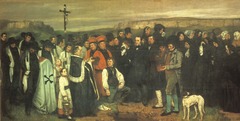
Figure 27-27 GUSTAVE COURBET, Burial at Ornans, 1849. Oil on canvas, 10' 3 1/2" x 22' 9 1/2". Musée d'Orsay, Paris.

answer
Courbet was the first artist ever known to set up his own exhibition outside the grounds, call it the Pavilion of Realism. His most famous statement - "I have never seen an angel. Show me an angel, and I'll paint one." Although as monumental in scale ( and considered his masterpiece) as a traditional history painting, Burial at Ornans horrified critics because of the ordinary nature of the subject and Courbet's starkly antiheroic composition. Although this bold, somber palette was essentially traditional, Courbet often used the palette knife for quickly placing and unifying large daubs of paint, producing a roughly wrought surface. His example inspired the young artists who worked for him ( and later Impressionists such as Claude Monet and Auguste Renior) but the public accused him of carelessness and critics wrote of his "brutalities."
question
Figure 27-28 JEAN-FRANÇOIS MILLET, The Gleaners, 1857. Oil on canvas, 2' 9" x 3' 8". Musée d'Orsay, Paris.

answer
Jean-Francois Millet and the Barbizon School painters specialized in depictions of French country life. Here , Millet portrayed three impoverished women gathering the scraps left in the field after a harvest. As did Courbet, Millet found his subjects in the people and occupations of the everyday world.
question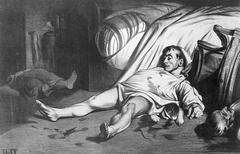
Figure 27-29 HONORÉ DAUMIER, Rue Transnonain, 1834. Lithograph, 1' x 1' 5 1/2". Philadelphia Museum of Art, Philadelphia (bequest of Fiske and Marie Kimball).

answer
Daumier used the recent invention of lithography to reach a wide audience for his social criticism and political protest. This print records the horrific 1834 massacre in the workers' housing block. In response, the authorities imprisoned him. A painter, sculptor, and, like Durer, Rembrandt, and Goya, one of history's great printmakers. Daumier produced lithographs that enabled him to create and unprecedented number of prints, thereby reaching an exceptionally large and broad audience. In addition to individual prints for sale, Daumier also contributed to the satirical lithographs to the widely read, liberal French Republican journal Caricature, further increasing the number of people exposed to his work. In Caricature, Daumier mercilessly lampooned the foibles and misbehavior of politicans, lawyers, doctors, and the rich bourgeoisie in general.
question
In 1798, the German printmaker Alois Senefelder
answer
created the first prints using stone instead of metal plates or wooden blocks. In contrast to earlier printing techniques, in which the artist applied ink either to a raised or incised surface, in ligthography (greek, "stone writing") the printing and nonprinting areas of the plate are on the same plane. See pg 778
question
Figure 27-30 HONORÉ DAUMIER, Third-Class Carriage, ca. 1862. Oil on canvas, 2' 1 3/4" x 2' 11 1/2". Metropolitan Museum of Art, New York (H. O. Havemeyer Collection, bequest of Mrs. H. O. Havemeyer, 1929).

answer
Daumier chose a cramped and grimy third class railway car of the 1860's to show how the poor were cramped together on hard benches stretching from one end of their carriage to the other.
question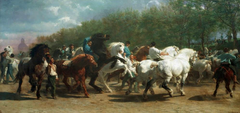
Figure 27-31 ROSA BONHEUR, The Horse Fair, 1853-1855. Oil on canvas, 8' 1/4" x 16' 7 1/2". Metropolitan Museum of Art, New York (gift of Cornelius Vanderbilt, 1887). This is Rosa's best known work.

answer
The most celebrated woman artist of the 19th century. Winner of the gold medal at the Salon on 1848, she became in 1894 the first woman officer in the French Legion of Honor. She received her training from her father, Oscar-Raymond Bonheur who was a proponent of Saint-Simonianism, an early 19th century utopian socialist movement that championed the education and enfranchisement of women.
question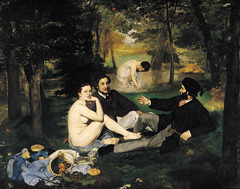
Figure 27-32 ÉDOUARD MANET, Figure 27-32 ÉDOUARD MANET, Le Déjeuner sur l'Herbe (Luncheon on the Grass), 1863. Oil on canvas, 7' x 8' 10". Musée d'Orsay, Paris. (Luncheon on the Grass), 1863. Oil on canvas, 7' x 8' 10". Musée d'Orsay, Paris.

answer
This audacious painting outraged the French public. It featured ordinary men and promiscuous women in a Parisian park. With Dejeuner, he sought to to reassess the nature of painting. This work contains sophisticated references and allusions to many artistic genres - history painting, portraiture, pastoral scenes, nudes, and even religious scenes. Le Déjeuner sur l'Herbe is Manet's impressive synthesis and critique of the entire history of painting. Manet aimed to move away from illuisionism toward an open acknowledgement of painting's properties, such as the flatness of the painting surface, which would become a core principle of many later 19th century painters as well as their successors to the present day. The style of the painting, couple with the unorthodox subject matter, made this painting one of the most controversial artworks ever created. 781
question
27.4 The French Academy and Other Classical Models
answer
* Examine the importance and influence of the French Royal Academy of Art, the artists it trained and the styles it promoted. * Understand the popularity of other classical models in art.
question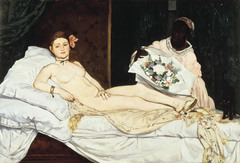
Figure 27-33 ÉDOUARD MANET, Olympia, 1863. Oil on canvas, 4' 3" x 6' 2 1/4". Musée d'Orsay, Paris.

answer
Even more scandalous to the French viewing public, however, was Manet's Olympia, painted in the same year as Le Dejeuner. The subject was a young white prostitute (Olympia was a common "professional" name for prostitutes in 19th-century France). 782
question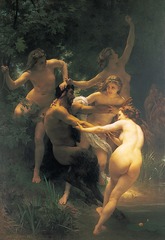
Figure 27-33A ADOLPHE-WILLIAM BOUGUEREAU, Nymphs and Satyr, 1873. Oil on canvas, approx. 9' 3/8" x 5' 10 7/8" high. Sterling and Francine Clark Art Institute, Williamstown, Massachusetts.

answer
Manet bases his work off of Bouguereau, who has been largely forgotten today, although he was a towering figure in the French art world during the second half of the 19th-century.
question
German and American Realism
answer
* Examine German artist's interests in regional and national characteristics, folk customs and culture. * Identify the American artists and key works of Realist art.
question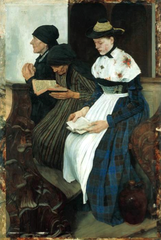
Figure 27-34 WILLIAM LEIBL, Three Women in a Village Church, 1878-1882. Oil on canvas, 2' 5" x 2' 1". Kunsthalle, Hamburg.

answer
French Realism spread quickly to Germany where Leibl painted this moving depiction of simple peasant women of different generations holding their prayer books in hands roughened by work.
question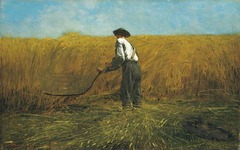
Figure 27-35 WINSLOW HOMER, Veteran in a New Field, 1865. Oil on canvas, 2' 1/8" x 3' 2 1/8". Metropolitan Museum of Art, New York (bequest of Miss Adelaide Milton de Groot, 1967).

answer
Realism received an especially warm welcome in the United States. One of the leading American Realist painters was Winslow Homer, of Boston. Homer experienced at first hand the most momentous event of his era - the Civil War. In 1860, he joined the Union campaign as an artist-reporter for Harper's Weekly. This veteran's productive work implies a smooth transition to peace after the Civil War, but Homer placed a single bladed sythe - the Grim Reaper's tool - in his hands, symbolizing the deaths of soldiers. It may also be a lamentation on the recent assassination of President Abraham Lincoln.
question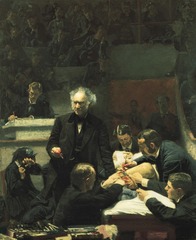
Figure 27-36 THOMAS EAKINS, The Gross Clinic, 1875. Oil on canvas, 8' x 6' 6". Philadelphia Museum of Art, Philadelphia.

answer
The too-brutal realism of Eakins's depiction of a medical college operating amphitheater caused this painting's rejection from the Philadelphia exhibit celebrating America's centennial. This painting portrays the renowned surgeon Dr. Samuel Gross in the operating amphitheater of the Jefferson Medical College in Philadelphia, where the painting hung for over 130 years until its sale in 2006 to raise funds for the college.
question
Figure 27-37 JOHN SINGER SARGENT, The Daughters of Edward Darley Boit, 1882. Oil on canvas, 7' 3 3/8" x 7' 3 5/8". Museum of Fine Arts, Boston (gift of Mary Louisa Boit, Florence D. Boit, Jane Hubbard Boit, and Julia Overing Boit, in memory of their father, Edward Darley Boit).
answer
This painting embodies the Realist belief that the artist's business is to record modern people in modern contexts.
question
Figure 27-38 HENRY OSSAWA TANNER, The Thankful Poor, 1894. Oil on canvas, 2' 11 1/2" x 3' 8 1/4". Collection of William H. and Camille Cosby.

answer
Henry Tanner was an African American artist that studied art with Eakins before moving to Paris. Tanner combined the Realists' belief in careful study from nature with a desire to portray with dignity the life of African American families. Expressive lighting reinforces the painting's reverent spirit. 785
question
Figure 27-39 EDMONIA LEWIS, Forever Free, 1867. Marble, 3' 5 1/4" high. James A. Porter Gallery of Afro-American Art, Howard University, Washington, D.C.
answer
The daughter of a Chippewa mother and African American father, produced work stylistically indebted to Neoclassicism but depicting contemporary Realism themes. She carved Forever Free four years after Lincoln's Emancipation Proclamation.
question
27.5 Pre-Raphaelites
answer
* Examine the Pre-Raphaelites' choice of subject matter in contrast to the Realists. * Understand the influences of the literary world and of the critic John Ruskin in the art of the Pre-Raphaelites. * Identify artists and styles of the Pre-Raphaelite movement. Realism did not appeal to all artiste, of course. In England, a group of painters who called themselves the Pre-Raphaelite Brotherhood refused to me limited to the contemporary scenes strict Realists portrayed. These artists chose instead to represent fictional, historical, and fanciful subjects, albeit with a significant degree of convincing illusion.
question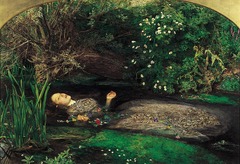
Figure 27-40 JOHN EVERETT MILLAIS, Ophelia, 1852. Oil on canvas, 2' 6" x 3' 8". Tate Gallery, London.

answer
One of the founders of the Pre-Raphaelite Brotherhood. The Pre-Raphaelites had a distaste for materialism and ugliness of the contemporary industralizing world. They also expressed an appreciation for the spirituality and idealism of past times, esp. the Middle Ages and Early Renaissance. 786
question
Figure 27-41 DANTE GABRIEL ROSSETTI, Beata Beatrix, ca. 1863. Oil on canvas, 2' 10" x 2' 2". Tate Gallery, London.

answer
This painting of a beautiful and sensous woman is ostensibly a literary portrait of Dante's Beatrice, but the work also served as a memorial to Rosetti's wife, who died of an opium overdose.
question
27.6 19th Century Architecture
answer
* Examine the variety of revivalist styles in architecture, the origins of the designs and their impact. * Discuss how the availability of new building materials will affect the structure and appearance of architecture
question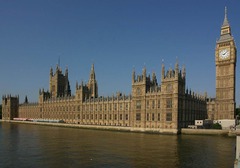
Figure 27-43 CHARLES BARRY and A. W. N. PUGIN, Houses of Parliament, London, England, designed 1835

answer
During the 19th-centuryl architects revived many historic styles, often reflecting nationalistic pride. The Houses of Parliament have an exterior veneer and towers that recall English Late Gothic style.
question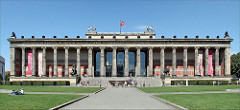
27-42 KARL FRIEDRICH SCHINKEL, Altes Museum, Berlin, Germany, 1822-1830.

answer
Schinkel conceived the first public art museum in Europe as a Neoclassical "temple of culture". The Altes Museum's facade of 18 iconic columns resembles an ancient Greek stoa. 787
question
Gothic Revival
answer
Gothic cathedrals, according to Chateaubriand, were translations of the sacred groves of the ancient Gauls into stone and should be cherished as manifestations of France's holy history. One result of this new nationalistic respect for Gothic style was that Eugene Emmanuel Viollet-le-Duc received a commission in 1845 to restore the interior of Paris's Notre Dame to its Gothic splendor after removing the Baroque and Napolenoic alterations.
question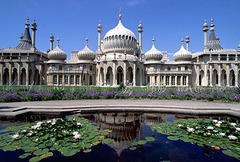
Figure 27-44 JOHN NASH, Royal Pavilion, Brighton, England, 1815-1818.

answer
British territorial expansion brought a familiarity with many exotic styles. This palatial "indian gothic" seaside pavillion is a conglomeration of Islmanic domes, minarets, and screens.
question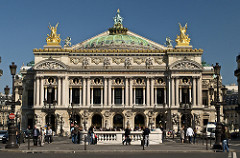
Figure 27-45 CHARLES GARNIER, the Opera, Paris, France, 1861-1874. Neo-Baroque facade

answer
The Baroque grandeur of the layout and of the bulding's ornamental appointments are characteristic of an architectural style called Beaux-Arts, which flourished in the late 19th and early 20th-century France. Based on ideas taught at the dominant Ecole des Beaux-Arts (School of Fine Arts) in Paris, The Beaux-Arts style incorporated classical principles (such as symmetry in design, including interior spaces extending radially from a central core or axis) and featured extensive exterior ornamentation. As an example of a Beaux-Arts building, Garnier's Opera proclaims, through its majesty and lavishness, its function as a gathering place for fashionable audiences in an era of conspicuous wealth. The style was so attractive to the moneyed classes who supported the arts that theaters and opera houses continued to reflect the Paris Opera's design until World War I transformed society.
question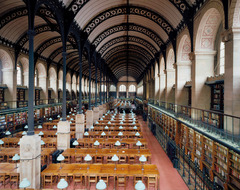
Figure 27-46 HENRI LABROUSTE, reading room of the Bibliotheque Sainte-Genevieve, Paris, France, 1843-1850.

answer
The exterior of this Parisian library looks like a Renaissance palazzo, but the interior has an exposed cast-iron skeleton, which still incorporates classical Corinthian captials and Renaissance scrolls.
question
Figure 27-47 JOSEPH PAXTON, Crystal Palace, London, England, 1850-1851; enlarged and relocated at Sydenham, England, 1852-1854. Detail of a color lithograph by ACHILLE-LOUIS MARTINET, ca. 1862. Private collection.
answer
The tensile strength of iron enabled Paxton to experiment with a new system of glass and metal roof construction. Constructed of prefabricated parts, the vast Crystal Palace required only 6 months to build.
question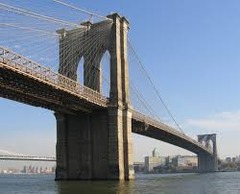
27-46A JOHN AUGUSTUS ROEBLING and WASHINGTON ROEBLING, Brooklyn Bridge, Brooklyn, New York, 1867-1883.

answer
Many of the 19th century architects were reluctant to surrender to traditional forms even when fully aware of new possibilities for design and construction. Architects scoffed at "engineers' architecture" for many years and continue to clothe their steel-and-concrete structures in the Romantic "drapery" of a historical style. The Brookly Bridge combined the latest steel technology with motifs from Gothic and Egyptian architecture.
question
27.7 Photography
answer
* Examine the origins of photography and its impact in visual art. * Discuss initial uses of the new art medium known as photography. * Recognize the artists and the works of early photography. * Examine artist's use and response to the technology of photography.
question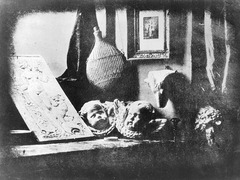
Figure 27-48 LOUIS-JACQUES-MANDÉ DAGUERRE, Still Life in Studio, 1837. 6 1/4" x 8 1/4". Daguerreotype. Collection Société Française de Photographie, Paris.

answer
Since its inception, people have celebrated photography's ability to make convinving pictures of people, places, and things. The relative ease of the process, even at its earliest and most primitive form, seem a dream come true for scientists and artists, who for centuries had grapples with less satisfying methods of capturing accurate images of their subjects. Photography also perfectly suited an age that saw the emergence of Realism as an art movement and a pronounced shift of artistic patronage away from the elite few toward a broader base of support. The growing and increasingly powerful middle class embraced both the comprehensible images of the new artistic medium and their lower cost.
question
What was the artistic communities reaction the camera?
answer
For the traditional artist, photography suggested new answers to the great debate about what is real and how to represent the real in art. Because photography easily and accurately enabled the reproduction of three-dimensional objects on a two-dimensional surface, the new medium also challenged the place of traditional modes of pictorial representation originating in the Renaissance. Artists as diverse as Delacroix, Ingres, Courbet, and the Impressionist Edgar Degas welcomed photography as a helpful auxillary to painting. Other artists, however feared the camera was a mechanism that would displace the painstaking work of skilled painters. 791
question
Figure 27-49 JOSIAH JOHNSON HAWES and ALBERT SANDS SOUTHWORTH, Early Operation under Ether, Massachusetts General Hospital, ca. 1847. Daguerreotype. Massachusetts General Hospital Archives and Special Collections, Boston.
answer
In this early daguerrotype, which predates Eakin's The Gross Clinic, by almost 30 years, Hawes and Southworth demonstrated the documentary power of the new medium of photography.
question
Daguerreotypes
answer
A type of photograph made by an early method on a plate of chemically treated metal; developed by Louis J. M. Daguerre.
question
Calotype
answer
From the Greek kalos, "beautiful". A photographic process in which a positive image is made by shining a light through a negative image onto a sheet of sensitized paper. 791-792
question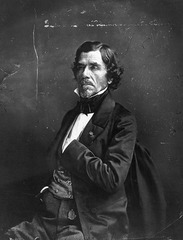
Figure 27-50 NADAR, Eugène Delacroix, ca. 1855. Modern print, 8 1/2"x 6 2/3" from original negative in the Bibliothèque Nationale, Paris.

answer
Gaspar-Felix Tournachon, aka Nadar was a french novelist, journalist, enthusiastic balloonist, and caricaturist, who beceme an early champion of photography. So talented was he at capturing the essence of his subjects that the most important people in France, including Delacroix, Daumier, Courbet, and Manet, flocked to his studio to have their portraits made. This photo is of Delacroix.
question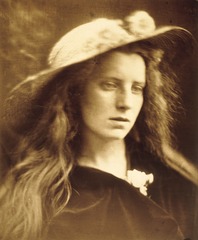
Figure 27-52 JULIA MARGARET CAMERON, Ophelia, Study no. 2, 1867. Albumen print, 1' 1" x 10 2/3". George Eastman House, Rochester (gift of Eastman Kodak Company; formerly Gabriel Cromer Collection)

answer
The slightly blurred focus became a distinctive feature of her work. The blurriness adds an ethereal, dreamlike tone to the photographs.
question
Figure 27-53 TIMOTHY O'SULLIVAN, A Harvest of Death, Gettysburg, Pennsylvania, July 1863. Negative by Timothy O'Sullivan. Original print by ALEXANDER GARDNER, 6 3/4" x 8 3/4". New York Public Library (Astor, Lenox and Tilden Foundations, Rare Books and Manuscript Division), New York.
answer
Wet plate technology enabled photographers to record historical events on the spot - and to comment on the high price of war, as this photograph of dead Union soldiers at Gettysburg in 1863.
question
Documentary power of the Photograph
answer
Photographers were quick to realize the documentary power of their new medium. Thus began the story of photography's influence on modern life and of the immense changes it brought to communication and information management. Historical events could be recorded in permanent form on the spot and for the first time. The photographs taken of the Crimean War (1856) by Roger Fenton, and of the American Civil War by Matthew B. Brady, Alexander Gardner and Timothy O'Sullivan remain unsurpassed as incisive accounts of military life, unsparing in their truth to detail and poignant as expressions of human experience.
question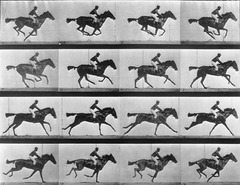
Figure 27-54 EADWEARD MUYBRIDGE, Horse Galloping, 1878. Collotype print, 9" x 12". George Eastman House, Rochester, New York.

answer
Muybridge specialized in photographic studies of the successive stages in human and animal motion - details too quick for the human eye to capture. Modern cinema owes a great deal to his work. Muybridge presented his work to scientists and general audiences with a device called a zoopraxiscope, which he invented to project his sequence of images (mounted on a special glass plate) onto a screen. The illusion of motion in his photographic exhibits was the result of a physical fact of human eyesight called "persistence of vision". Stated simply, it means the brain retains whatever the eye sees for a fraction of a second after the eye stops seeing it. Thus, viewers saw a rapid successon of different images merging one into the next, producing the illusion of continuous change. The Cinema was born!



